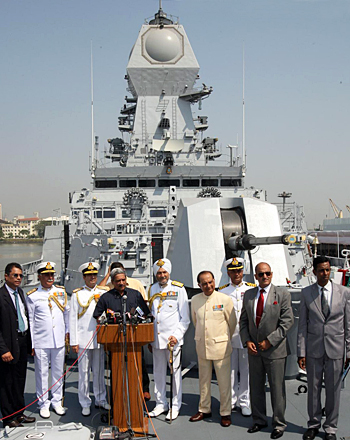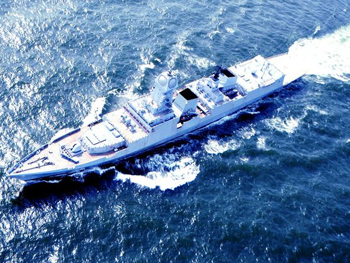INDIAN ARMED FORCES CHIEFS ON
OUR RELENTLESS AND FOCUSED PUBLISHING EFFORTS

SP Guide Publications puts forth a well compiled articulation of issues, pursuits and accomplishments of the Indian Army, over the years

I am confident that SP Guide Publications would continue to inform, inspire and influence.

My compliments to SP Guide Publications for informative and credible reportage on contemporary aerospace issues over the past six decades.
- Prime Minister witnesses 'Bharat Shakti' – a Tri-Services Firing and Manoeuvre Exercise in Pokhran, Rajasthan
- Interim Defence Budget 2024-25 — An Analysis
- Union Defence budget 2024
- Prime Minister Modi Commemorates Indian Navy Day in a Grand Ceremony
- Prime Minister Modi Flies in the LCA Tejas
- New Chapter in India-Italy Defence Ties
- Airpower beyond Boundaries
INS Kochi named after traditional home of Destroyers
The ship design not only incorporates most advanced design concepts for improved survivability, stealth, sea-keeping, and manoeuvrability; its weapons and sensors are those of the best in the class.
 |
By Rear Admiral Sushil Ramsay (Retd) Senior Technical Group Editor, SP's M.A.I. |





INS Kochi - Profile
The Type II Hunt Class Destroyers of World War II fame were sanctioned to be leased from Royal Navy to Indian Navy during June 1952, and subsequently sold to India in 1958. The first ship was commissioned as INS Ganga on June 18, 1953. Subsequently, two more ships of the class, INS Godavari and Gomati were commissioned to form the 22nd Destroyer Squadron (22 DS). Initially, 22 DS was based at Bombay to be part of the Indian Fleet and thereafter transferred to Cochin during early 1960s. Cochin then came to be known as the home port of Indian Navy’s Destroyers which performed the sterling role of training, being co-located with all specialised Training Schools at Cochin. It was a befitting tribute to the traditional home of Destroyers to have its name etched on the plaque of Indian Navy’s most powerful Guided Missile Destroyer of Project 15A, Kolkata Class.
The ship’s crest depicts a sword and a shield together with a Snake Boat riding on the blue and white ocean waves, which symbolise the Malabar region’s rich maritime heritage and martial traditions.
INS Kochi, the second ship of Project 15A, is a follow-on programme of the first indigenously designed Delhi Class, Guided Missile Destroyers. It is to the entire credit of the Directorate of Naval Design (Surface Ship Group) to churn out a highly sophisticated and most advanced design of this 7,000 tonne man of war for the Indian Navy. The ship design not only incorporates most advanced design concepts for improved survivability, stealth, sea-keeping, and manoeuvrability, its weapons and sensors are those of the best in the class.Although the Project 15A has suffered a setback of at least five years in churning out the first of line INS Kolkata, Mazagon Dock Ltd., Mumbai, the shipbuilders have taken adequate measures to obviate further slippages or delays. Accordingly, the second in line, INS Kochi has been commissioned 13 months later and the last of the class INS Chennai is expected to be commissioned end 2016.
The Defence Minister said the Government is seized of the Nation’s defence requirements and requisite financial support for the Armed Forces and defence industry will be made available, which includes the modernisation and development plans of the Navy.
INS Kochi, with a displacement of 7500 tons, 164 meters in length and 17 meters at the beam, is powered by four gas turbines to achieve maximum speed of 30 knots plus. The ship has a complement of about 40 Officers and 350 Sailors. The accommodation and living spaces have been designed with special emphasis on ergonomics and habitability. Enhanced stealth features have been achieved through shaping of hull and use of radar-transparent deck fittings. A bow mounted Sonar Dome, the second of its kind in an indigenous naval platform, has been introduced to enhance sonar acoustic performance.
INS Kochi is the second ship packed with the most sophisticated state-of-the-art weapons and sensors including Multi-Function Surveillance and Threat Alert Radar (MF STAR) to provide target data to the vertically launched Long Range Surface to Air Missile system (LR SAM). The MF STAR and LR SAM systems are jointly developed by Defence Research and Development Organisation and Israel Aerospace Industries Ltd.
The ship is equipped with the advanced supersonic and long range BrahMos, Surface to Surface Missile. The 76 mm Super Rapid Gun Mount (SRGM) and AK 630 CIWS, both manufactured indigenously, can take on air and surface targets. The entire anti-submarine weapon and sensor suite fitted onboard, consisting of Indigenous Rocket Launchers, Indigenous Twin-tube Torpedo Launchers and a bow-mounted New Generation HUMSA Sonar are fine examples of indigenous efforts in the field of underwater warfare. The sensor suite includes other advanced Surface to Air surveillance radars and an indigenous Electronic Warfare System. A state-of-the-art Combat Management System (CMS- 15A) has been integrated with the onboard weapons and sensors. The ship is equipped to operate two Seaking or Chetak Helicopters.
The Ship can be truly classified as a 'Network of Networks' as it is equipped with sophisticated digital networks, such as Asynchronous Transfer Mode based Integrated Ship Data Network (AISDN), Combat Management System (CMS), Automatic Power Management System (APMS) and Auxiliary Control System (ACS). The AISDN is the information highway on which data from all the sensors and weapon ride. The CMS is used to integrate information from other platforms using indigenous data-link system, to provide Maritime Domain Awareness. The intricate power supply management is done using APMS, and remote control and monitoring of machinery is achieved through the ACS.
Commissioning
While commissioning INS Kochi on September 30, 2015, the Defence Minister, Shri Manohar Parrikar said the Government is fully committed to developing a real Blue Water Navy, a Navy which can dominate the Indian Ocean Region (IOR), but will be considered friendly by the neighbouring countries. He gave two examples to illustrate his point- that of transporting drinking water to Maldives when the latter’s water treatment plant was damaged last year, and the rescue and evacuation of nationals of over 20 countries from war-torn Yemen by the Indian Navy, without any damage to our platforms and personnel.
Shri Parrikar said there has been a renewed enthusiasm among DPSUs and the Private Sector in the development and production of platforms and systems for the Defence Forces and the government has been consistently trying to indigenise and speed-up timely deliveries. He hoped that the next Destroyer in the series will be put into water by the end of the current financial year.
Shri Parrikar said while we have achieved significant indigenisation in ‘Float’ component of warships, we are lacking in the indigenisation of the high-end Fight components. To that end, the Government is in the process of putting a policy in place to achieve high amount of self- reliance in the defence industry under the guidance of the Prime Minister Shri Narendra Modi.
The Defence Minister said the Government is seized of the Nation’s defence requirements and requisite financial support for the Armed Forces and defence industry will be made available, which includes the modernisation and development plans of the Navy. Towards this the Government shall always remain committed to provide the necessary funds for the future expansion and growth of the Navy.
The commissioning ceremony was attended among others by the Chief of Naval Staff Admiral RK Dhowan, Flag Officer Commanding-in-Chief, Western Naval Command, Vice Admiral SPS Cheema; and the Chairman and Managing Director of Mazagon Docks Limited, Rear Admiral RK Shrawat (Retired).
Speaking on the occasion, Admiral RK Dhowan said that commissioning of INS Kochi is a milestone in the self-reliance programme of the Navy and stated that the indigenisation of platforms, weapons, sensors and equipment, through public as well as private sectors, will continue to remain a focus area of the Indian Navy. He emphasised that the 'Roadmap for the Navy's expansion and growth would continue to remain firmly anchored on Self-reliance and indigenisation'.
"INS Kochi will add more teeth to the Indian Navy's sword arm in discharging our duty of safe-guarding maritime interests in the IOR. It further reaffirms our resolve and faith in indigenous ship-building and the 'Make in India' programme.” “The Indian Navy no longer has to order platforms from abroad and has built up the capability to build from aircraft carriers to submarines and over forty eight platforms are on order in India, none abroad.” He added.
The Commanding Officer, Captain Gurcharan Singh, read out the Commissioning Warrant, prior to the hoisting of 'Colours' (the national flag and naval ensign) for the first time onboard the ship. Following her commissioning, INS Kochi will be based at Mumbai, under the operational and administrative control of the Flag Officer Commanding-in-Chief, Western Naval Command.





